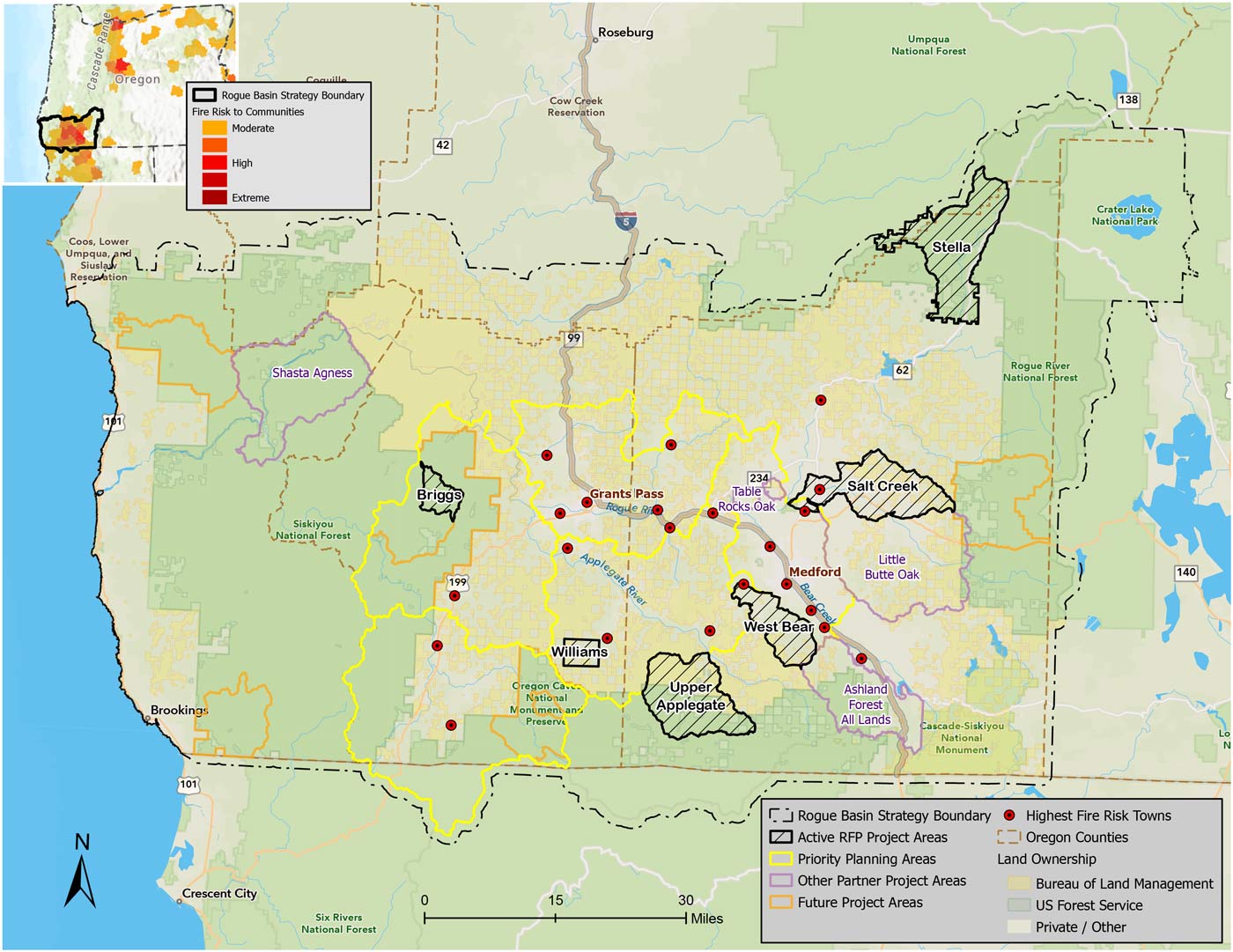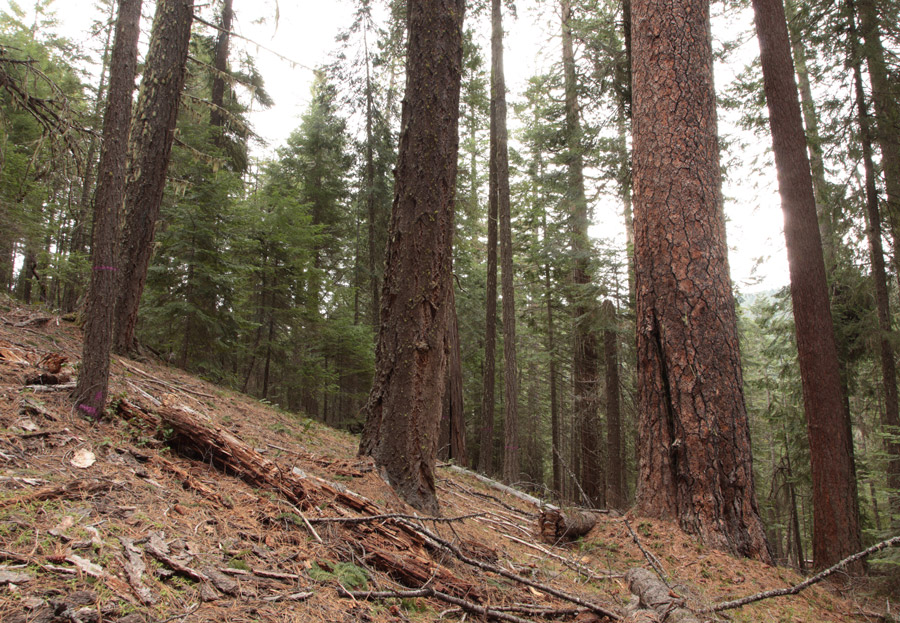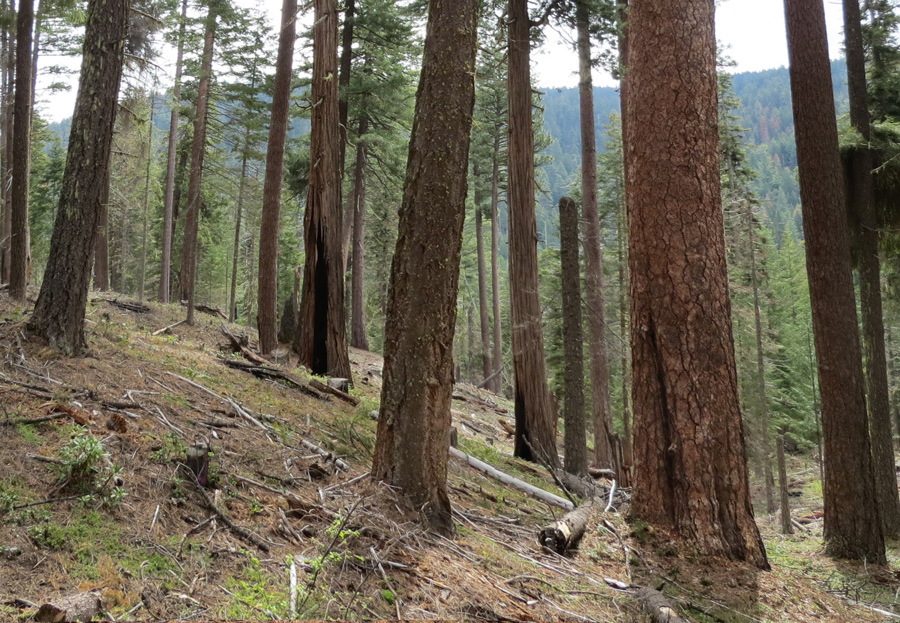Project Areas
Our forests need help
The magnificent forests of the Rogue Basin are one of our greatest community assets. Southern Oregonians live, recreate, hunt and fish here. Forests provide vital habitat for wildlife and essential ecosystem services including clean air and a secure supply of drinking water. They are a source of jobs and natural resource products. Forests inspire all by sustaining a human connection to place for present and future generations—including the indigenous peoples who have been a part of the landscape since time immemorial and are an important part of the community today.
Before and After Ecological Thinning
The unnaturally severe wildfires and widespread tree die-offs of recent years are an indicator that forests need our help.
For millennia, Rogue Basin mixed-conifer forests were maintained by frequent, low-severity fires burning every three to thirty years. But the elimination of indigenous peoples’ fire practices, extensive logging of the largest and most fire-resistant trees, and a steady increase of fire suppression over the past century have had unintended consequences. Woodlands and forests are now overly dense, with fuel-laden understories. They’re filled in with uniformly young trees, with too few old, large, fire-tolerant trees.
Working together, we are continuously learning more about the science of forest health. The Rogue Forest Partners are putting this knowledge to work to benefit forests and communities.
Project Footprint
Our initiative will benefit over 6,000 acres, including priority USFS, BLM and private forestlands in the Applegate and Illinois Valleys, Stella, Salt Creek, Briggs, and Williams. Preparations began in 2019, and forest restoration work—including ecological thinning, ridge and mid-slope fuels reduction, and prescribed burning,—will continue until 2025.
We’re working together to restore these important dry forests and oak woodlands to a more fire-¬resilient state, so they’re better able to withstand wildfire, insects, disease and climate change, and give firefighters better, safer options during fires. The benefits for southern Oregon are many:
Reducing risks to life and property from severe wildfire.
Planned Acres to be Treated
Set in the Klamath bioregion, the 3.3 million-acre Rogue Basin is a mosaic of forests, meadows, and rivers that flourish with wildlife, native wildflowers, rare habitats and provides a wealth of ecosystem services. Our six project areas seek to treat one-quarter of the dry-type forests with strategic thinning and controlled burning:
RFP has identified six projects across the Rogue Basin. These high-priority areas, spanning public land and private tracts, are critically important for reducing the risks of extreme wildfires, promoting forest health, and restoring resilience to our landscape. The work began in the Applegate and Illinois Valleys in 2020 and continues into 2025.

The Upper Briggs Restoration Project on the Wild Rivers District in the Illinois Valley supports diverse habitats and forest conditions. This ridge burned in the Klondike/Taylor fire, but from ridge to stream, one encounters legacy trees to protect, dense understories to be thinned and chaparral patches intermixed. The ridgeline is important for managing fires moving from wildlands toward Illinois Valley communities.
The Williams Project near the community of Williams in Josephine County is focused on reducing fuels and improving forest habitat through restoration treatments on federal and private lands in an all-lands effort bringing together the BLM and NRCS with the RFP to demonstrate restorative wildfire risk reduction. Together, we are working toward the landscape-vision of the RBS.
The West Bear Project addresses the need for wildfire fuels reduction immediately adjacent to the cities of Jacksonville, Phoenix, Talent, and Medford. The 27,000-acre project area within the wildland urban interface west of Bear Creek and the I-5 corridor is one of the most at-risk locations for wildfire in Oregon.
The 50,000-acre USFS and BLM Upper Applegate Watershed Project (UAW) is located in the Applegate Valley with over 18,000 acres of planned restoration treatments designed during a three-year community planning process convened by the Siskiyou Mountains Ranger District of the RRSNF. Some 3500 acres are scheduled by RFP to be completed by 2025. The UAW is one of the highest priority areas for restoration under the RBS.
The Stella Landscape Restoration Project project occurs in the most productive corner of the Rogue Basin, where the lack of low-intensity fire and past management has resulted in high-density stands and declining forest health. To improve wildlife habitat and forest health and build ecosystem resilience to wildfire, the Stella Project will strategically apply ecological thinning (both non-commercial and commercial) and prescribed fire to achieve restoration goals across a 43,955-acre footprint.
The Salt Creek Project planning area is large but RFP work with the BLM starts with a small footprint of fuels treatments in oak woodlands. The treatments will demonstrate ecological restoration under the RBS in these dry but diverse oak habitats and help reduce wildfire risks near the communities of Eagle Point.
A Strategic Approach
RFP’s work is part of the Rogue Basin Strategy, which aims to return resilience to forestlands using ecological forestry on a quarter of the landscape, with mechanical fuel reduction, forest thinning, and prescribed burning to benefit forests and local economies. Spanning eco-regions from the Western Cascades and Klamath Mountains to the Coast Range, this guiding strategy addressed 4.6 million acres. The thoughtful design considered the diverse mosaic of forests, meadows, and rivers that flourish with wildlife, native wildflowers, rare habitats, and provides a wealth of ecosystem services.
The six initial projects led by Rogue Forest Partners advance a 20-year path toward treating one-quarter of the dry- forests in the greater strategy footprint.
Goals
Reduce combined resource and human wildfire risks by up to 70%
Deliver 83 million board feet of federal timber to local mills annually (enough to build 5000 homes)
Science and collaborative decision making are the bedrock of effective and adaptive management of forests and fire that work for society and ecology.
Kerry Metlen, The Nature Conservancy
Healthier forests mean healthy communities.
Everyone in the Rogue Basin is connected to the forests. Our forested mountains have been the source of food, livelihoods, valuable wood products, eco-cultural resources, diverse wildlife, recreational opportunities, and clean air and water for millennia. Together, we can ensure that future generations will continue to enjoy these benefits and that our region will continue to harbor the extraordinary diversity of plant and animal life and landscapes that make it such a special place. It will take many of us working together today if we want sustainable, productive forests tomorrow.


